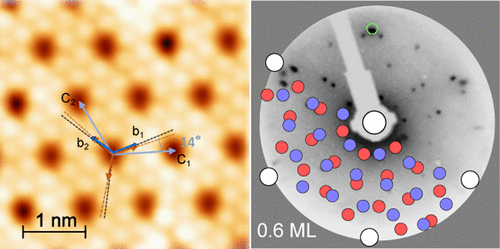Epitaxial films of a transition metal dihalide grown on gold
Magnetic two-dimensional (2D) semiconductors have attracted a lot of attention because modern preparation techniques are capable of providing single crystal films of these materials with precise control of thickness down to the single-layer limit. It opens up a way to study a rich variety of electronic and magnetic phenomena with promising routes towards potential applications.
The integration of 2D materials in technologically relevant applications requires an atomic-scale control of the growth of single crystalline, monolayer-thick films. While many semiconducting 2D materials like graphene, h-BN or MoS2 are routinely grown on the wafer scale, the preparation of magnetic 2D materials is still limited in most cases to micromechanical exfoliation.
Prominent exceptions to this trend are magnetic transition-metal tri- and dihalides, for which single-layer growth was demonstrated recently via molecular beam epitaxy. In contrast to well-studied trihalides, particularly CrI3 and CrBr3, the experimental investigation of 2D dihalides is less advanced, even though their bulk magnetic properties have been thoroughly studied.
Bulk FeBr2 is a layered crystal belongs to the family of transition metal dihalides (TMDH). It consists of covalently bonded layers stacked via van der Waals interactions in the CdI2-type structure (P3m1 space group). The layers consist of triangular lattices of cations forming one transition metal layer sandwiched between two halide layers. It is the indirect Fe-Fe exchange interaction which gives rise to the collinear intralayer ferromagnetic order at temperatures below 14.2 K, while the interlayer exchange is antiferromagnetic. The application of an external magnetic field of 3.15 T triggers a metamagnetic phase transition.

Now, a team of researchers uses 1 the sublimation of the stoichiometric powder to grow epitaxial films of magnetic semiconductor FeBr2 on a single crystal of Au(111).
The feasibility of growth of TMDH films via chemical vapour deposition (CVD) has only been demonstrated recently. In contrast to CVD, molecular beam epitaxy (MBE) does not require heating the substrate above room temperature, which makes it compatible with resist-based nanofabrication and opens up a way to the integration of TMDH thin films in scalable manufacturing processes.
In this work, the researchers investigated the initial stages of epitaxial growth of FeBr2 on a single-crystal Au(111) substrate by means of low-temperature scanning tunnelling microscopy, low-energy electron diffraction, x-ray photoemission spectroscopy, low-energy electron emission microscopy and x-ray photoemission electron microscopy.
The magnetic properties of the one- and two-layer thick films were measured via x-ray absorption spectroscopy/x-ray magnetic circular dichroism. The results show a striking difference in the magnetic behaviour of the single layer of FeBr2 and its bulk counterpart, which can be attributed to the modifications in the crystal structure due to the interaction with the substrate.
These findings open the prospect for further investigation of the monolayers of the 2D magnetic TMDH. In contrast to the trihalides family that features the honeycomb arrangement of the magnetic atoms within the 2D layers, triangular nets of magnetic atoms in TMDH are prone to frustration that leads to degeneracy of the magnetic ground state and potentially may result in stronger response towards external stimuli. This feature might result in a rich variety of interesting physical phenomena and opens a way for using 2D magnetic TMDH compounds in applications.
Author: César Tomé López is a science writer and the editor of Mapping Ignorance
Disclaimer: Parts of this article may have been copied verbatim or almost verbatim from the referenced research paper/s.
References
- Sebastien E. Hadjadj, Carmen González-Orellana, James Lawrence, Djuro Bikaljević, Marina Peña-Díaz, Pierluigi Gargiani, Lucia Aballe, Jan Naumann, Miguel Ángel Niño, Michael Foerster, Sandra Ruiz-Gómez, Sangeeta Thakur, Ivar Kumberg, James M. Taylor, Jack Hayes, Jorge Torres, Chen Luo, Florin Radu, Dimas G. de Oteyza, Wolfgang Kuch, José Ignacio Pascual, Celia Rogero, and Maxim Ilyn (2023) Epitaxial Monolayers of the Magnetic 2D Semiconductor FeBr2 Grown on Au(111) Chem. Mater. doi: 10.1021/acs.chemmater.3c00978 ↩